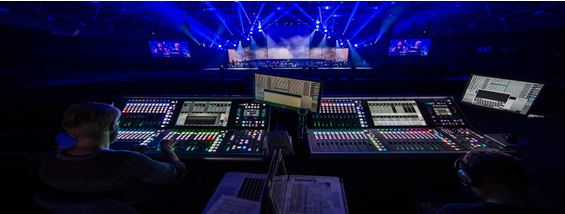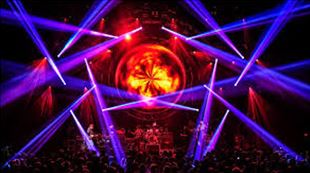Music News - FYI: Stage Setups
05 September 2016 - 0 Comments
Many a band has been faced with the dilemma of how to integrate the sounds of their individual instruments and the Public Address (PA) system. The challenge that they face is the audial flexibility and clarity on stage, where they are playing, to bringing that same quality of music to the audience anywhere from the front of the stage to the folk all the way at the back. Although the subject of PA would fill volumes and is outside of the scope of this article, I am hoping to address some of the more fundamental issues that confront a band and how to achieve the more basic of setups and arrangements that confront a rock band.
Instrument Amplifier Placement

To many musicians, the question of amplifier placement is not one that poses much difficulty. The fundamental question as it were, must be that it is on stage with them and they need to be in close proximity for both the ability to hear the sound coming out of the amplifier and to be able to make any changes as required.
One of the many considerations confronting the sound engineer who is mixing the band, is how to get the balance of sound with what the band is creating on stage and what is be projected to the audience, and believe me there is a very real difference. Added to this is the physical limitations that the venue might impose on the band in regard to how much space is available for the band to actually perform on. So the problem escalates when a template or layout that has been arranged by the band in their rehearsal set up doesn’t match that of the venue’s performance space.
In the above examples we see that there are some fundamentals that are duplicated on just about every stage that has been played on. There are a row of musical instruments that sit at the back of the band facing in the direction of the audience with the drums taking centre stage sometimes on a riser and the other instrument amplifiers in close proximity to the drummer and the rest of the band.
So the question that I guess is what do you need to know if you are in charge of setting up the stage for the band. In most cases the musicians in the average garage band will each take responsibility for the placement and power supply of their own instrument with appropriate leads being run as required, either to a mixer or the instrument or power outlets as available. They then, on discussion, decide hopefully before they start the setup, on how best to use the venues stage and how it matches with their rehearsal template and what changes need to be made.

Although the above illustration doesn’t show the exact placement of the instruments on the stage, it does show the elements that can be found in a modern rock band, i.e.: drums, 2 to 3 guitars, vocal mics. The key element here, is knowing that there are a number of instruments that are more powerful than others, some are totally acoustic, the drums usually, and others that have a dial that can be turned to facilitate a balancing of the volumes.
Knowing this, is not the complete picture though because it still doesn’t address the question of balancing the individual instruments for the separate needs of the different artists.
The physical arrangement of the amps and instruments is only half the picture of sound control on stage as the visual impact that the band may have designed is also a consideration for stage set up. Remember that normally there will be some form of advertising or graphic that sits behind the band as part of their performance. So don’t be too rigid on the rehearsal map unless it is integral to your performance or elements within your act. If you are a little flexible with your amplifier and instrument placement it will go a long way to helping the band with quick and less stressful setups.

In the bigger venues, outdoor stages and festival set ups, many stage producers, will use a row of amplifiers and speaker boxes as a backdrop to the band, but the real sound that is projected to the audience comes from a set of smaller instrument amps at the back or off stage somewhere with a microphone stuck in front of the speaker. The sound is then fed back to the musicians through their foldbacks and split between the on stage mix and the front of house mix. This is mainly because putting live performers in front of a sound amplification system that pumps out thousands of watts worth of SPL (Sound pressure level) is a quick trip to instant deafness.
Stage Safety
Over the years I have found that one of the constant problems facing stage crew or the muso’s who are doing their own set up, as happens with most working bands, is the neglect that they have for personal safety around the stage. If you want to be technical about it, the stage is a work environment and it does comes under the OHS rules when dealing with safety in the work place. So what does this mean to the average garage band or the newly beginning professional act. Essentially it means that someone in the band or stage crew needs to take, or be made responsible for ensuring the safety of the stage. That means with the placement of the electrical leads, ropes, speakers, lighting and effects machines and any other article or piece of gear that is going to be on the stage with the band and that it is not going to be a health risk.
Strictly speaking the stage set up should take place in a way that ensures that only those who are doing the set up do the assembly of the stage. They should not put themselves or other members of the band or public at risk whilst doing this by letting people wander willy nilly through the stage whilst constructing the stage.
In an ideal world, one person takes responsibility for placing and fixing all running gear in place on the stage with the gear being ferried to him or her as required so that no confusion and double handling takes place. It will take some doing as most folk will just want to get on with it and all rush on to the stage and start putting stuff in place where they think it should go and start making connections. There truly is a right way and a wrong way to go about setting up a stage. And yes sadly I have been party to the common method of setup and suffered the frustrations that accompany the pandemonium that breaks out when all the band get on the stage and start manoeuvring drum kits and amps around each other whilst trying to tell each other what to do and what leads go where etc. Organised pandemonium would describe this scenario best. One final word on band safety is that the use of duck tape to secure leads and lines is an industry standard for good reason, mainly because it works and as much as I expect there will be those who will poo-poo the idea, but learning to work with earplugs and or in ear fold back is a long term investment in still being able to hear the music when you get to your 40’s and 50’s without having to live with a constant ringing in your ears called tinnitus.
Running the leads
One of the most common things on a stage to fail is a lead. Either a guitar lead, or a microphone lead. Sometimes a power lead can also be a problem, but the evidence of that is very quickly discovered.
This can mean that extra care is taken with how the leads are run from Mic’s to mixers, Power leads are run to Amps, Lighting rigs are secured from falling over, or PA speakers from falling over when members of the audience in states of drunken frenzy cannon into the stand that is supporting your $2000 speaker or lighting rig. I have seen it happen far too often, and sometimes it has caused some real harm to members of the public or band.
Harmonic buzzes and hums
Another reason why it is pretty important to get the leads and power cords under control is because they can cause problems with the sound you get from amps and the PA. There is an audio nightmare facing the sound engineer when he or she is trying to track down a low level hum or buzz from either a faulty lead or power cross talk from adjacent leads. One of the most bizarre of audio nightmares is when a band member uses a curly lead for their instrument to the amp and in the middle of a performance a truckie’s conversation on the radio that is passing by interrupts the massive lead solo that the guitarist was just getting into. It happened because I was there, the turns of the lead and the distance that the lead is extended can become a radio antenna and so become a source of real sound problems. With the more modern set ups today we now have radio mic’s and transmitters for both vocals and instruments, and although they can be great to work with as a musician, or vocalist, they pose a problem all of their own if not set up properly and especially if someone didn’t put some new batteries into the rigs from the last gig.
It is one of the more frequently asked questions that I get when discussing the use of radio mics as well as the need for good frequency separation between the units, thankfully most of the medium to more expensive systems have no real problem with this. Neon lighting systems are notorious for creating low frequency hums and buzz’s or when you take power from a system at the venue that has things like fridges and lighting systems that sequentially start and stop on a timed arrangement. You will spend ages trying to isolate an irregular pop or click if you don’t know where your power is coming from. So do your research.
PA Placement
So once we have the band more or less settled on the stage for their performance, the lights and the effects rig all dialled in, we then come to the other part of the stage setup which the band will rely on and that is the PA. The arrangements and the diversity that is presented to the audio engineer when addressing the requirements of a band can be quite confronting. From a simple set of speakers with a basic mixer to the multi layered towering array of multiple boxes and relevant gantries to support the whole configuration we quickly come to realise that this business of sound reinforcement and propagation is not as easy as initially though.
From the simple to the complicated
In coming to grips with this problem, it is important for band member to understand that what they produce in a limited and controlled situation in the rehearsals studio is going to be entirely different to when they are taking their music to the performance stage. It goes without saying that having a PA system that meets most average bands needs will not require a rocket scientist to set up and operate, however for those who find themselves playing at larger venues, do not make the mistake of trying to compensate for the lack or inability of the PA by turning your instrument amplifiers up to the max and telling the drummer to kill himself behind the kit. You’re simply asking for trouble and you really just need to get a better PA for that gig.
Integrating Lighting and Effects
Simple Lighting
There is much to be said for the use of simple lighting to enhance the performance of an act, but knowing the difference between a spot, flood, Can or LED is probably a good place to start with. So for the uninitiated, a Spot is a light that can be focused and gives a very narrow and powerful light (Eg 1)over a long distance, a flood is generally a larger bodied light with the ability to light a larger area with a flat lighting source eg: example 2 with a single colour wash that paints all the surround area in a particular hue, a Can or sometimes referred to as Rock and roll cans are generally an array of multi coloured flood lights arranged on a pole that can operate individually, sequentially or all together to produce different hues or one single colour as designed by the lighting specialist. As seen in example 3.
Then finally the LED lighting, which achieves the same effects as the floods and Cans but is not generally used with Spot requirements. Example 4.
Complex Lighting
Needless to say that complex lighting is a subject in itself which does fall out side the scope of this article other than to say that it requires an array of multi tasked lighting systems, that are either motor driven and sometimes multi directional. The multi bank arrays have a range of different effects from strobing to laser that can be used simultaneously or independently, a computer program is required to control the movement and firing sequence and having a whole lot of money is the only way you are ever going to play with one of these systems unless you are working for the guy who owns it.
I guess in summing up, the array of considerations that a band must confront, as it makes its way from rehearsals to performance, is considerable. Irrespective if you are a garage band just doing it for fun and some pocket money or if you are hoping to become the next big thing, the journey will always begin with understanding that some thought will need to go into how you perform your first or next gig and what can you do to make it better. Having expert advice along the way is now no longer a choice really, as without it you will set yourself up to fail or you will struggle as a going concern in the competitive market of the music industry. On reflection as I write this the hardest part in some regards has been to decide what not to write about as there are so many other aspects to the question of preparing, planning and presenting a musical performance.
Written by Paul Harvey.
Most Viewed Artists
Latest Galleries
NZ Top 10 Singles
- APT.
ROSÉ And Bruno Mars - DIE WITH A SMILE
Lady Gaga And Bruno Mars - BIRDS OF A FEATHER
Billie Eilish - TASTE
Sabrina Carpenter - I LOVE YOU, I'M SORRY
Gracie Abrams - ESPRESSO
Sabrina Carpenter - SAILOR SONG
Gigi Perez - LOSE CONTROL
Teddy Swims - A BAR SONG (TIPSY)
Shaboozey - GOOD LUCK, BABE!
Chappell Roan

















 Report A Problem
Report A Problem


There are currently no comments for this article. Please log in to add new comments.